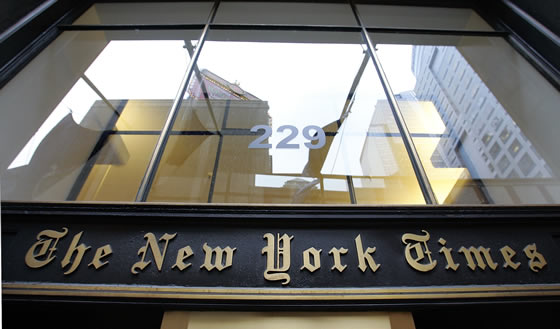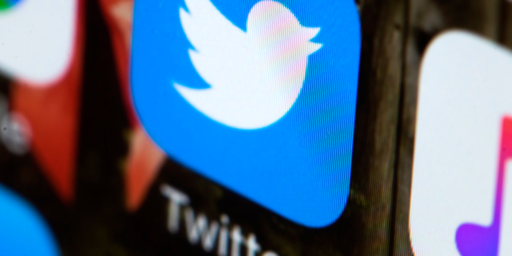New York Times Transitioning to Web Only
New York Times chairman Arthur Sulzberger says, “I really don’t know whether we’ll be printing the Times in five years, and you know what? I don’t care either.” He spells out his vision for the future in an interview with Eytan Avriel of Haaretz.
Sulzberger says the New York Times is on a journey that will conclude the day the company decides to stop printing the paper. That will mark the end of the transition. It’s a long journey, and there will be bumps on the road, says the man at the driving wheel, but he doesn’t see a black void ahead.
[…]
Classifieds have long been a major source of income to the press, but the business is moving to the Internet. Sulzberger agrees, but what papers lose, Web sites gain. Media groups can develop their online advertising business, he explains. Also, because Internet advertising doesn’t involve paper, ink and distribution, companies can earn the same amount of money even if it receives less advertising revenue.
Really? What about the costs of development and computerization? “These costs aren’t anywhere near what print costs,” Sulzberger says. “The last time we made a major investment in print, it cost no less than $1 billion. Site development costs don’t grow to that magnitude.”
Truly visionary, right? The owner of the most prestigious newspaper in the United States has finally caught up to Jeff Jarvis, who has been arguing for years that the business of media companies is not papers but rather content.
Sulzberger has not quite made the mental conversion necessary for the Internet age, however.
Will it be free?
No, Sulzberger says. If you want to read the New York Times online, you will have to pay.
Then the New York Times will exist only as a niche paper. Slate, Salon, and others have tried and failed going the subscription-only route. There’s simply too much good content out there that’ openly accessible. Just as with the print editions now, newspapers will need to figure out how to build their business models around advertising or something other than subscriptions. People simply aren’t willing to pay more than a nominal price for access to information, especially when similar content is available free elsewhere.
As a minor aside, it strikes me as odd to break this story at Haaretz rather than, I dunno, the New York Times?
Don Surber, meanwhile, thinks that if Sulzberger’s premise that people “want reliable news that they can trust” is correct, the NYT might be in trouble. Pretty funny, if ultimately unfair. Despite my skepticism of their editorial slant and their numerous publicized troubles, I still find the NYT among the premier sources for news out there.
Nobody gets it right all the time, not the big papers, not broadcast, and certainly not blogs. The key is to read multiple sources and apply skepticism and your own judgment. Surber’s maxim, “Cite, but verify. Never trust again.” is quite right.
via Memeorandum






Impossible to see how the pressmen’s union is going to like this.
We still have a massive free rider problem.
The NYT and others pay for the collection of news and the rest of the web free rides on this.
WE have a basic problem that want ads cross subsidized the collection of news and nothing has emerged to replace this.
So if people are not willing to pay for the NYT, or others who is going to pay for news collection?
What are the NYC commuters going to read on the subway? The NY papers make a good amount of their money from the commuter crowd. This is something people often overlook if they don’t live in NY. The Time could of course set up free giveaway papers like the Post does in DC with the “Express” papers they hand out at Metro stations, and make the money off the advertisers.
So if people are not willing to pay for the NYT, or others who is going to pay for news collection?
Plenty of Web enterprises subsist with advertising. So, too, does CNN, Fox News, and others.
What are the NYC commuters going to read on the subway?
That thought occurred to me as well. Likely not the NYT, though, since they insist on keeping the antiquated broadsheet format. That’s hard enough to read on one’s couch, let alone on a crowded subway. You’ll note that the “Express” is a tabloid.
Last October I visited U. of Nevada, Reno, and at the library hall I could see several piles of NYT to be distributed freely to students. By lunch time the piles were still large. What a waste of paper!
There is no free riding problem here. The paper edition is mainly to provide commercial information about products and companies will find other effective ways to provide this information (initially a little more expensive). The same applies to occasional, noncommercial information. The news in paper editions are largely provided by news agencies that have already been providing them through TV, radio and other means. And finally the so-called analysis of news (99% of what appears as “only” news in NYT) has already been competing with (and increasingly losing to) the analysis provided by many others in Internet. So the end of the paper edition will affect only a few people that used to read it in their way to office or back home; soon they will find there are other things to read much better than the NYT.
James – I am a product of the NYC school system. Back in the day, we received the NY Times in middle school and were taught how to fold the paper in the correct way to read it on the subway. I’ll admit most of the subway hoi polli have copies of the Daily News or the Post, but there are plenty of folks who do read the Times or the WSJ on the trains.
So they are already at a tipping point. 1.5 million on line and 1.1 million in print. And this for a “national” paper. With a population of over 8 million in the city and nearly 19 million in the metropolitan ares, plus they advertise on TV to deliver it here in Texas, they sell only 1.1 million print copies. And I use the word sell generously as noted in the comments above.
Why do I get the feeling if the right stopped using them as a punching bag they would fade like Air America.
YAJ – While the 1.1 million print circulation might seem small, the NYT is the 3rd largest paper in the country, right behind USA Today and the WSJ. By comparison, the NY Daily News and the Post have numbers slightly above 700k. The WaPo’s numbers are about 930k. Most other “major” papers are lucky to be over 500k.
I’d like to know how many of 1.1 million papers are distributed freely to college students.
DC Loser,
The point I am making is that they are reaching such a small portion of their audience already. I think it speaks of a problem with the print media in general, so comparing them to other walking wounded is problematic.
The New York Post is a fair comparison, and I suspect their editorial stance in a blue state speaks more to the relative numbers than anything else.
WSJ is much more than a New York paper (though obviously the financial community on Wall Street is an important consideration). Likewise, the USA today is an example of a paper being truly national.
The Washington Post is an interesting comparison. I’m not to keen on their editorial stance, but I hold them in higher regard than the NYT. They do about 650K circulation out of a 5 million metropolitan population or 13% (not great but not bad). Admittedly the area probably has a higher news junky ratio than anywhere else in the country.
The LAT pulls 850K out a 13 million metropolitan area or about 6.5% (half the post). Compare this to the NYT pulling 5.9% of their metropolitan area. And the NYT is getting more out of area subscriptions I bet than the Washington Post or the LAT.
YAJ – Actually, the Post does quite well against the Times at the newstands. Their tablod format, its populist writing, and sports coverage, plus its afternoon late editions, are very popular. The prime readership, the working class NYers, don’t really read the editorial page.